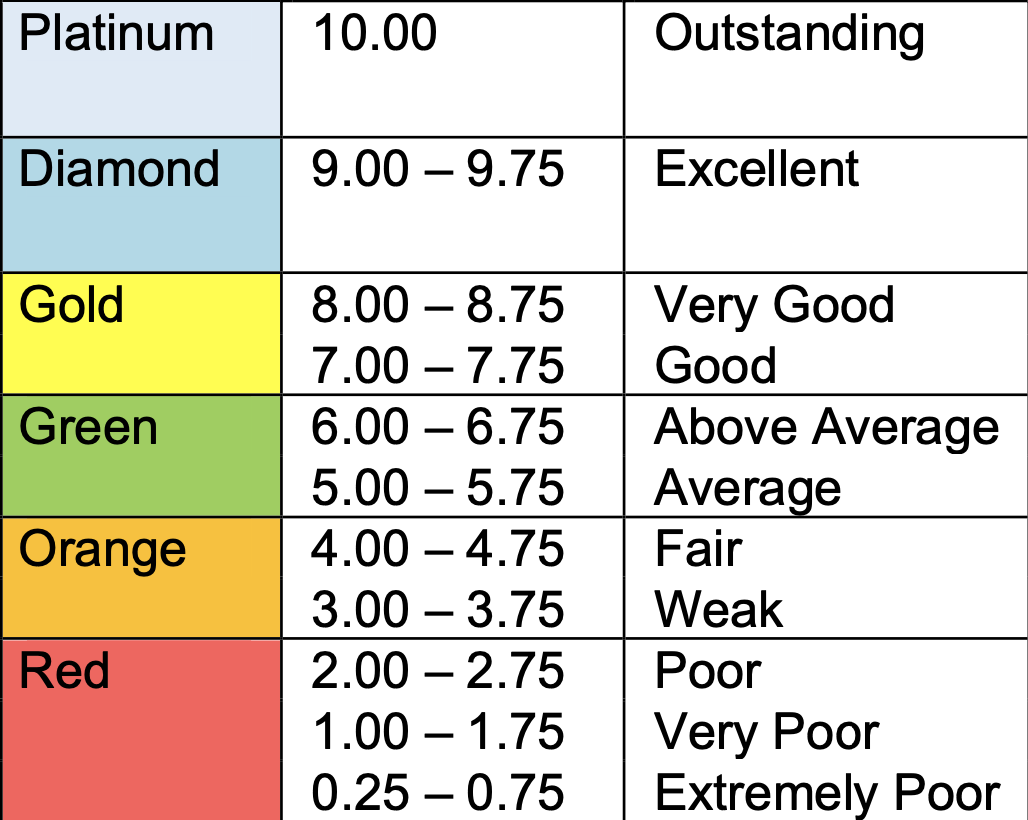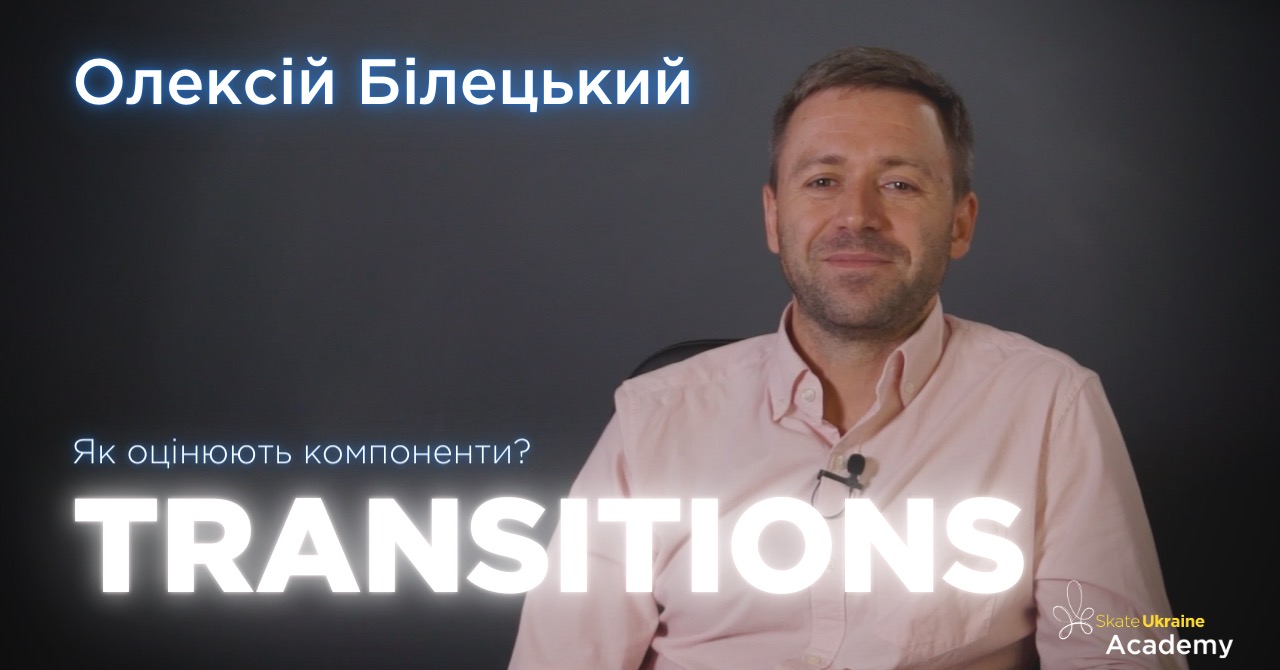Dear friends, I’m Oleksiy Biletskyi, a figure skating official, ISU Judge in single & pair skating and ice dancing. I have officiated more than 50 events, including World and European Championships. As a skater, I took part in 2002 Winter Olympics in Salt Lake City.
Here I continue discussing how we judge, see and mark skaters’ performances. Understanding what and how we do will help you make your programs better, more interesting so we, the judges, mark them higher.
If you want to make your results better – watch this video!
Today we will discuss Transitions.
TRANSITIONS
They are connecting steps, positions, movements and holds between the elements.
There are four defining criteria:
- Continuity of movements from one element to another;
- Variety;
- Difficulty;
- Quality;
And we evaluate them on a scale from 0 to 10 points in increments of 0.25 points.
On the web you can find the Chart created by the ISU with a colored evaluating manual:

- Red – very poor
- Orange – poor
- Green – mediocre
- Gold – good
- Diamond – excellent
- 10 – outstanding
And we put these marks counting the percentage of criteria completed according to the program timing. Later I will show the example.
Now there is the first criterion.
CONTINUITY OF MOVEMENTS FROM ONE ELEMENT TO ANOTHER
How do we recognize it? When the program looks like a continuous spectacle. Integrating difficult elements like jumps, spins, step sequences to the program to create this spectacle, enhance the effect from it. Such program creates the feeling of continuity – a spectacle from start to finish.
There are some moments that can break the performance:
- Long preparation for elements. Especially – jumps.
- When a skater “turns off” and tries to rest during the skate.
- Mistakes and interruptions when a skater “stops” the program after a fall from a jump or a spin. Sometimes a skater just stands still instead of trying to improvise.
- Too many crossovers.
I need to say that transitions include not only steps but also arms, legs and body movements.
VARIETY
Variety of steps, turns, positions and holds (in pairs and ice dancing)
How can you make them various? The blade has not only two edges but also the heel and toe parts. You can do turns and leaps on them. They may not be difficult movements, but they will meet the variety requirement. Tere are also lunges, spread eagles, ina bauers, spirals and their variations.
Variety of holds and positions in pairs and ice dancing .
Variety of positions and short lifts. Create something unique, your own original element – within the rules, please!
DIFFICULTY
You can do difficult steps and turns holding the body straight and adding leans using the legs, arms and your head. So the movements become spacial and difficult.
You can do a simple step or a turn but do it leaning the body or straightening your arm or leg sideways. Then this movement can become unique and difficult, because you need a balance. And this will raise your Transition mark significantly.
Variety of turns' directions. Especially in contrast.
Elegant and balanced execution of turns, steps, movements and their combinations.
Perfect execution of rockers, counters, three-turns, twizzles, S-steps (choctaws) and outside C-steps (mohawks).
What else can raise the mark for this component?
Movements, steps, execution quality – and all that has to be remembered. And even better – be unique. Then your mark will be high.
QUALITY
It is different like the skaters’ level. Different skaters do steps and turns according to their level. So, we have different quality and different levels of skating skills and body control.
CONCLUSION
As I have told, the program that looks like a spectacle from start to finish, have a continuous action with difficult and high-quality execution of various movements, steps and turns will receive higher Transitions mark.
You have to think which movements fit the skater better, what they can do, how their skating skills are used. If a skater can do spread eagles – great, they sould be included in programs. If they can do a “shoot-the-duck” – show that. If they can do a split jump – do it. If they can do some unique element – they also should do it.
It will raise the Transition mark and the originality of the program in general. So it will be the best way to show strengths and abilities of the skater.
Demo
What did Patrick demonstrate here?
Let’s look at our criteria:
- Here we have integral composition, mini-spectacle – no doubts with that. So, we have continuity of movements from one element to another. Elements are integrated to the program. Entries and exits to and from elements are almost invisible. I can say that here we have Continuity of more than 90%.
- Variety of steps, turns, movements and positions. Between elements, he demonstrated steps, toe usage, leaps, various turns, spread eagles. All of that – before and after elements – deserves more than 90%.
- Difficulty. Of course, Patrick has executed even simple turns, which he has combined with body movements – his limbs were aside of the center of gravity. Also he had dynamics and contrast in his movements. The only minor problem here is too many crossovers on element entries. Because of that, here my mark for Patrick is 80-85%
- Quality. The quality of execution is very high – this skater has great technique and executes all movements with a very high quality level. So, more than 90% here.
So, after adding all the criteria for Transitions Patrick will receive 9-9.25 points.
Tonya Harding – the skater who had some of the best jumps in the 90s.
- Continuity of movements from one element to another. During the first part she made a long entry – then a jump, then again an entry and a jump. Then in the middle there was a lyrical part where she executed spirals and an Ina Bauer – both were quite great. Not all elements were integrated into the program, so for this criterium, I could put 55-65% here.
- Variety of steps, turns, movements and positions. Not many. Mostly – backward crossovers. So, this criterion is met by only 40-50%.
- Difficulty. Also was not demonstrated – some turns, arcs, small body leanings, mostly crossovers. Mostly no bodywork, and arm movements are very limited. So, 40-50% here.
- Quality. The quality of execution of her simple movements and steps was above average. Also, the high speed can be mentioned. So, this criterion is met by 60-70%.
And the Transition mark for Tonya after adding the criteria will be 5.5-6.5 points.
Good luck to you on your practices and competitions, and remember – the best one wins! Practice well, and the result will come! Watch the video, ask your questions – there will be more interesting and useful stuff here. With the love for the sport, Oleksiy Biletskyi!


